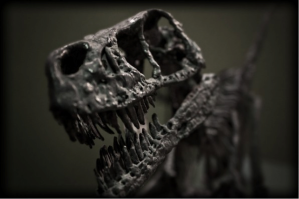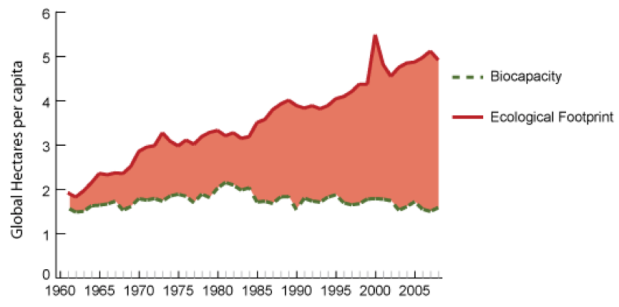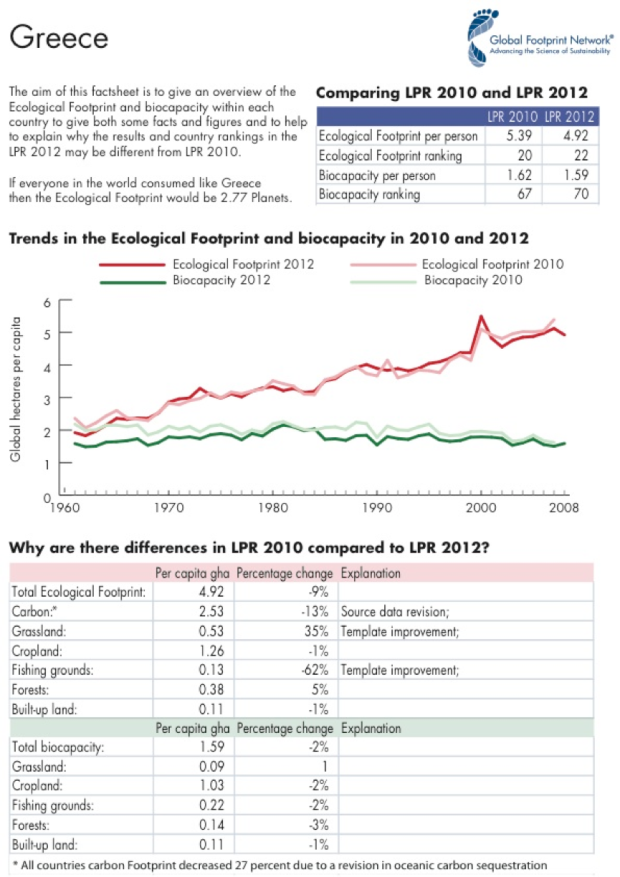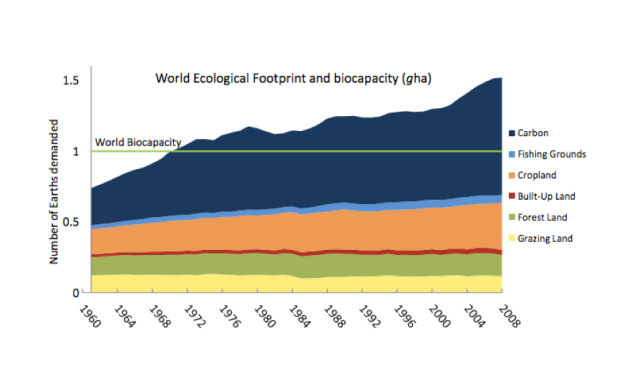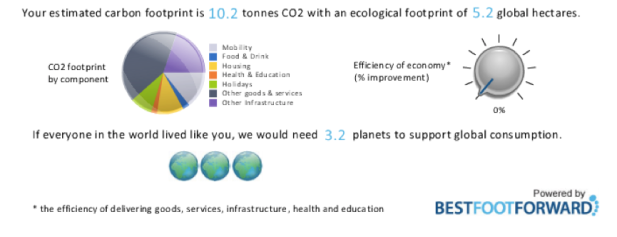This post is going to describe the upcoming “Sixth Great Extinction” and the concept of the ecological footprint. In addition, it will explain how these concepts affect Homo Sapiens species and the human behavior.
The Sixth Great Extinction
First of all, what is extinction? Extinction is the disappearance of a species from earth, due to their inability to evolve from simple to complex in order to survive in a changing environment. Extinction is an irreversible situation; once a species is lost, it lost forever.
There were five vast mass extinctions that took place in our world the past six hundred million years. Each one of them resulted in a fifty to seventy percent extinction of all the species lived in earth until then.
(Major Extinctions)
The fifth extinction, as demonstrated in the table, is the most common to people, since the dinosaurs become extinct due to an asteroid impact on earth.
After the previous mass species extinctions, our world is about to face the Sixth Great Extinction, which is estimated to be the more catastrophic one. “Overexploitation of species for consumption, collection and trade, agricultural monoculture, human-induced climate change, nitrogen loss in soil and oceanic acidification as a result of a warming climate, and urbanization” are some of the key factors contributing to the upcoming extinction. Human population nowadays increasing dramatically, and as a consequence the demand of natural resources will continue to grow in a way that is totally unacceptable by the nature. (“The Sixth Great Extinction”)
It is said that the Sixth Great Extinction will occur due to the disastrous for the universe species Homo Sapiens, and began about 100,000 years ago. Moreover, it is estimated that half of all the current species living in earth today, including plants, animals and birds, will die off before 2100. (“The Sixth Great Extinction”)
After every mass extinction, as illustrated in the chart, the biodiversity either returned to or exceeded its original state. The situation will not be the same in the Sixth mass extinction. Suppose that the average number of people on Earth during the recovery period of the previous extinctions is 2.5 billion (by contrast with the 6 billion today). “Under these conditions, the total number of people affected by what we do during the next few decades will be about 500 trillion.: So humanities are involved in a very crucial decision ever taken by them.” Undoubtedly, the upcoming extinction will alter not only biological diversity, but also the evolutionary processes by which diversity is generated. (Meyers)
(The Road to Sanity)
Humans do not live with nature but outside it.
Earth can’t sustain the trend in human population growth. It is reaching its limit in carrying capacity.
Overpopulation, invasive species, and overexploitation are fueling the extinction.
Only 10% of the world’s species survived the third mass extinction. Will any survive this one?
Wherever early humans migrated, other species became extinct.
The invention of agriculture accelerated the pace of the Sixth Extinction.
The previous mass extinctions were due to natural causes, where the current mass extinction is caused by humans.
About 30,000 species go extinct annually.
(Eldredge)
Ecological Footprint
Humanities depend upon what nature provides, but in what ways do they know how much they are using in contrast to how much they have to use?
The Ecological Footprint is the measure of humanity’s demand on nature. “This accounting system tracks, […] , how much land and water area a human population uses to provide all it takes from nature. This includes the areas for producing the resource it consumes, the space for accommodating its buildings and roads, and the ecosystems for absorbing its waste emissions such as carbon dioxide.” Biocapacity is the supply of nature; in other words, biocapacity is the measurement of how much biologically productive area is available to provide the services mentioned above to humanity. Furthermore, the concept of the “overshoot ”, is the point where human consumption and waste production exceed nature`s capacity to create new resources and absorb waste. (Footprint Basics)
The accounts comparing human demand against nature’s supply of biocapacity vary among nations. Greece’s Ecological Footprint, as demonstrated below, exceeds the supply of biocapacity, since the Ecological Footprint is 4.92 hectars per capita in contrast to the 1.59 hectars per capita supplied by nature (biocapacity); in addition, its Ecological Footprint exceeds the world’s average Ecological Footprint (4.92 VS 2.7 hectares per person) (Footprint Basics)
In the graph we can identify that the nation’s biocapacity keeps falling while the demand of Ecological Footprint raises as the years go by. Undoubtedly, the more we harm and exploit the environment, the less the biocapacity it serve to us. If we keep on harming the environment the way we do now, the future would be disastrous, since we would not anymore be welcomed by the nature; a situation should be taken under serious consideration by everyone. (Footprint Basics)
…if everyone in the world consume like a midde Greek, then the EF would be 2,77 planets…
That is, every people in the world consume like an average Greek, then we would definitely need 1.7 more planets in order for us to survive!
Taken into consideration the chart, we realize that the developed countries have an increased Ecological Footprint, whereas the underdeveloped countries had a decreased one. For instance, USA and Germany, which are 2 of the most developed countries in all around the world, with a high GDP per capita, tend to have the higher scores in the EF measurement; on the other hand, underdeveloped countries such as Afghanistan and Egypt, with a low GDP per capita, have an interestingly low EF. This is due to the fact that the developed countries tend to exploit the earth in a high level; in addition, their citizens have acquired a luxurious way of living, and that means that they consume brazenly, whereas citizens of underdeveloped countries are unable to afford more and more new, high-tech goods, and, consequently, do not harm the environment.
In the graph above, we can see the most recent estimate of the world Ecological Footprint & Biocapacity.
Having taken the test to identify my Ecological Footprint, I got very disappointed. If all humanity had the same lifestyle with mine’s, then we would need another 2.02 earths to survive.
In addition, my ecological footprint is even higher than the average of my country’s one. My results would be decent though, if I was a citizen of Germany or USA, since my lifestyle is more close connected to those countries. Overall, I was somehow embarrassed about that and I’ll try to do my best to reduce this number. Here’s a video suggesting ways to reduce our own Environmental Footprint.
http://www.youtube.com/watch?v=p9cCFBcVRO4
All societies should make efforts to reduce their EF, not only to leave more resources available for nations with smaller footprints, but also for their own benefit; reducing the Ecological Footprint equals upgrading the way of living and turning the nation into a sustainable one.
To conclude, I do believe that every nation having an Ecological Footprint higher than their biocapacity, has a moral obligation to reduce its EF. Humanities sometimes act and behave in a very egocentric way, not thinking about their descendants’ lives. We should all be aware of our EF and try to reduce it if it exceeds the biocapacity that nature serves us. Issues mentioned above like extinction and loss of biodiversity, lie only upon humanities; we are responsible for our future and we, through our behavior, determine what is going to happen in the future.
Works Cited
Eldredge, Niles. “The Sixth Extinction.” (ActionBioscience). N.p., June 2001. Web. 10 Mar. 2013.
“Footprint Basics – Overview.” Footprint Basics – Overview. N.p., n.d. Web. 10 Mar.2013. <http://www.footprintnetwork.org/en/index.php/GFN/page/footprint_basics_overview/>.
Major Extinctions. Digital image. Teara.govt. N.p., n.d. Web. 10 Mar. 2013 <http://www.teara.govt.nz/en/diagram/13650/major-extinctions>.
Myers, Norman. “How Will the Sixth Extinction Affect Evolution of Species?”(ActionBioscience). N.p., May 2001. Web. 10 Mar. 2013.
The Road to Sanity. Digital image. Declineoftheempire.com. N.p., 2 Aug. 2012. Web.10 Mar. 2013 <http://www.declineoftheempire.com/2012/02/the-sixth-extinction.html>.
“The Sixth Great Extinction: A Silent Extermination.” News Watch.Nationalgeographic.com, 28 Mar. 2012. Web. 10 Mar. 2013.

